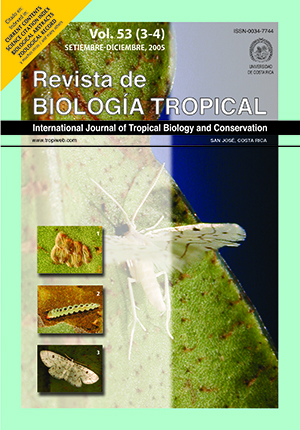Abstract
The study of local cetaceans in Venezuela has a very recent history, and few efforts have been made in the assessment of coastal populations based on field research. The occurrence of whales and dolphins along the northeast coast of Venezuela has been documented through sightings and stranding records. Given the underwater topographical features and the influence of upwelling processes, this area is considered a very productive coastal ecosystem. Our objective was to establish the sighting frequency and relative abundance of bottlenose dolphins in the area. Sighting records were gathered on bottlenose dolphins and other cetacean species occurring along the northeast coast of Margarita Island and Los Frailes Archipelago through direct observation during land-based (6 surveys, 48 hours of observation) and boat-based surveys (24 surveys, 121 hours of observation, 1295 km covered). A sighting frequency was calculated using two methodologies and then compared, considering: 1) a mean effective observation time (4.27 hours), and 2) distance covered with cetacean sightings (1108 km). A third method is proposed relating a mean effective distance covered with cetacean sightings and expressed as a percentage. The abundance index was calculated using the mean effective observation time. The sighting frequency of Tursiops truncatus in the study area was 3 - 4 sightings per day of 4.27 observation hours, or by 185 kilometers covered. The relative abundance was calculated as 35 dolphins in the study area, so a total population of less than 60 dolphins could inhabit the proposed range. Tursiops truncatus is the dominant species in the northeast coast of Margarita Island and Los Frailes Archipelago with 70% of all the sightings, so this locality could be termed as the distribution range of a possible local population of bottlenose dolphinsReferences
Acevedo, R. 2001. Distribución y caracterización de hábitat de cetáceos marinos reportados en las costas de Venezuela. Tesis de Pre-Grado. Universidad Central de Venezuela, Caracas. 243 p.
Aguayo, A., R. Bernal, C. Olavarria, V. Vallejos & R. Hucke. 1998. Observaciones de cetáceos realizadas entre Valparaíso e Isla de Pascua, Chile, durante los inviernos de 1993,1994 y 1995. Rev. Biol. Mar. Oceanogr. 33: 101-123
Bello, R., M. Schreiber & R. Sánchez . 1998. Distribución y abundancia relativa de cetáceos durante el crucero de BIC Humbolt 9709-10, de Mataraní a Paita. Inf. Inst. Mar Perú, 130: 78-85.
Castellanos P. 1997. Distribución temporal de la temperatura superficial del mar en la región sur del Caribe (observaciones con el AVHRR) Tesis de Pre-Grado, Instituto Universitario de Tecnología del Mar. Fundación La Salle de Ciencias Naturales. Isla de Margarita, Nueva Esparta, Venezuela 70 p.
Debrot, A., J. De Meyer & P.J.E. Dezentjé. 1998. Additional records and a review of the cetacean fauna of the Leeward Dutch Antilles. Carib. J. Sci. 34(3-4): 204-210.
Evans, W.E., J.R. Jehl & F.H., Wolfson. 1977. Biological study of the Venezuelan jetfoil route from Pto. La Cruz to Porlamar: final report. Hubb’s Sea World Research Institute. Technical report H/SWRI 77-102. 25 p.
Gonzales, M. 2000. Determinación del estado actual de los cetáceos de las costas del estado Aragua. Resultados de la etapa II: Borrador preliminar del informe técnico final. Servicio Autónomo Profauna, Dirección de Manejo de Fauna Acuática / Ministerio del Ambiente y de los Recursos Naturales Renovables. Aragua, Venezuela. 44 p.
Llano M., Y. Astor, B. Acevedo, J. García, K. Delgado & N. Seguías. 1999. Caracterización físico-natural del área marino costera de la región oriental de Venezuela para el desarrollo armónico de oriente. Plataforma continental de los Estados Anzoátegui, Sucre y Nueva Esparta. Fundación La Salle de Ciencias Naturales, Estación de Investigaciones Marinas de Margarita (EDIMAR). Informe Técnico. Isla de Margarita, Venezuela.175 p.
Lorenzoni, L. 2000. Detección de surgencias en costas Venezolanas mediante sensores remotos. Tesis de Pre- Grado, Universidad Simón Bolívar, Caracas.70 p.
Mignucci, A. 1998. Zoogeography of cetaceans off Puerto Rico and the Virgin Islands. Carib. J. Sci. 34(3-4): 173-190.
Naveira, J.L. 1996. El orden cetacea en la región nororiental de Venezuela. Tesis de Maestría. Instituto
Oceanográfico de Venezuela, Universidad de Oriente, Cumaná, Venezuela. 181 p.
van Bree, P.J. 1975. Preliminary list of the cetaceans of the Southern Caribbean. Stud. Fauna Curaçao Carib. Islands 160: 2-12.
Wells, R. & M.D. Scott. 1999. Botlenose dolphins Tursiops truncatus (Montagu, 1821), p. 137-182. In Ridgway, S.H. & R. Harrison (eds). Handbook of Marine Mammals. Vol. 6: The Second book of dolphins and the porpoises. Academic Press, Orlando, Florida.
##plugins.facebook.comentarios##

This work is licensed under a Creative Commons Attribution 4.0 International License.
Copyright (c) 2005 Revista de Biología Tropical






